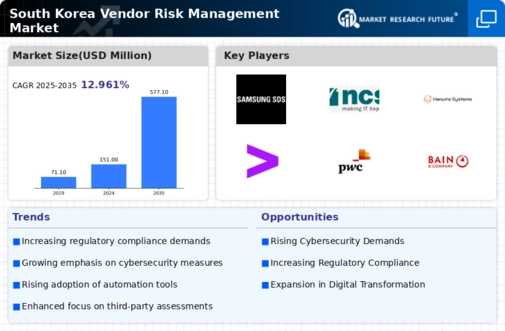Rising Cybersecurity Threats
The vendor risk-management market is experiencing heightened demand due to the increasing prevalence of cybersecurity threats in South Korea. Organizations are recognizing the necessity of robust vendor risk management strategies to mitigate potential breaches that could arise from third-party relationships. In 2025, it is estimated that cybercrime could cost South Korean businesses upwards of $30 billion annually, underscoring the urgency for effective risk management solutions. As companies strive to protect sensitive data and maintain customer trust, investments in vendor risk-management tools are likely to surge. This trend indicates a growing awareness of the interconnectedness of vendor relationships and cybersecurity, compelling organizations to adopt comprehensive risk assessment frameworks to safeguard their operations.
Growing Demand for Automation
The vendor risk-management market is being propelled by the growing demand for automation in risk assessment processes. South Korean businesses are increasingly adopting automated solutions to streamline vendor evaluations and enhance efficiency. In 2025, it is anticipated that automation technologies will reduce the time spent on vendor risk assessments by up to 40%. This shift not only improves operational efficiency but also allows organizations to focus on strategic decision-making rather than manual processes. As companies seek to optimize their vendor management practices, the integration of automation tools is likely to become a key driver in the vendor risk-management market, enabling firms to respond swiftly to emerging risks and maintain compliance with regulatory requirements.
Evolving Supply Chain Dynamics
The vendor risk-management market is influenced by the evolving dynamics of supply chains in South Korea. As businesses increasingly rely on global suppliers, the complexity of managing vendor relationships has intensified. In 2025, approximately 70% of South Korean firms are expected to report challenges in maintaining visibility and control over their supply chains. This complexity necessitates the implementation of sophisticated vendor risk-management solutions to identify, assess, and mitigate risks associated with third-party vendors. Companies are likely to invest in technologies that enhance supply chain transparency, enabling them to proactively address potential disruptions and ensure compliance with regulatory standards. The focus on supply chain resilience is expected to drive growth in the vendor risk-management market as organizations seek to fortify their operations against unforeseen challenges.
Increased Focus on Sustainability
The vendor risk-management market is witnessing a shift towards sustainability as South Korean companies prioritize environmental, social, and governance (ESG) criteria in their vendor selection processes. In 2025, it is projected that over 60% of organizations will incorporate sustainability metrics into their vendor risk assessments. This trend reflects a broader commitment to responsible sourcing and ethical business practices. As firms seek to align their operations with sustainable development goals, they are likely to demand greater transparency from their vendors regarding their environmental impact. Consequently, the vendor risk-management market is expected to expand as organizations implement frameworks to evaluate and manage the sustainability risks associated with their supply chains, thereby enhancing their overall corporate responsibility.
Heightened Awareness of Compliance Risks
The vendor risk-management market is experiencing growth due to heightened awareness of compliance risks among South Korean organizations. As regulatory frameworks become more stringent, businesses are compelled to ensure that their vendors adhere to legal and ethical standards. In 2025, it is estimated that compliance-related penalties could exceed $1 billion for non-compliance in various sectors. This reality is prompting organizations to invest in comprehensive vendor risk-management solutions that facilitate ongoing monitoring and assessment of vendor compliance. The focus on compliance is likely to drive the adoption of advanced risk management tools, as companies strive to mitigate potential legal repercussions and protect their reputations in an increasingly regulated environment.






















Leave a Comment